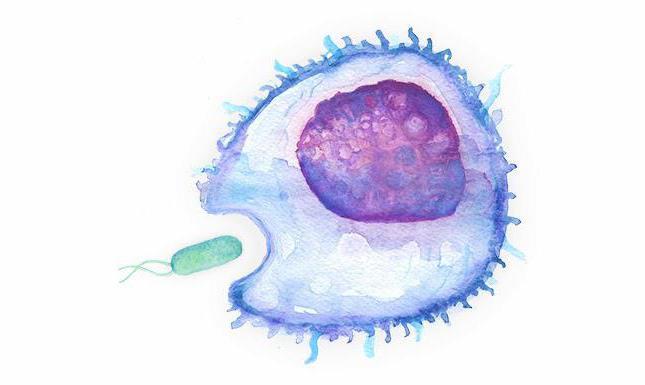Lysosomes are cellular "orderlies"
Each living cell has a set of structures thatgive her the opportunity to demonstrate all the properties of a living organism. In order to function properly, the cell must receive enough nutrients, split them and release energy, which then will be used to support vital processes.
At the first stage of complex processes of energy management are the lysosomes of the cell, which are ligated along the edges of flattened dictyosome cisterns (the Golgi complex).

How are lysosomes arranged
Lysosomes are spherical single-membrane bodiesdiameter from 0.2 to 2 μm, in which a complex of hydrolytic enzymes is enclosed. They are able to split any natural polymer or substance of complex structure that enters the cell as a nutrient substrate or foreign agent:
- proteins and polypeptides;
- polysaccharides (starch, dextrins, glycogen);
- nucleic acids;
- lipids.
This efficiency is provided by about 40 different types of enzymes, contained both in the matrix of the lysosome, and on the inner side of the membrane in the adhered state.
Chemistry of lysosomes
The membrane surrounding the lysosome protects the organellesand other components of the cell from digestion by a complex of enzymes. But in fact in the bubble all enzymes are of protein origin, why are they not cleaved by proteases?
The fact is that inside the lysosomes the enzymes are in the glycosylated state. This carbohydrate "shell" makes them poorly recognizable for proteolytic enzymes.
The reaction of the medium inside the lysosome is weakly acidic (pH 4.5-5), in contrast to the almost neutral reaction of the hyaloplasm. It creates favorable conditions for the action of enzymes and is provided by the work of H+-ATPase, which pumps protons into the organelle.
The process of transformation of lysosomes
Morphologically, two basic types of lysosomes are distinguished in the cell - primary and secondary.
Primary lysosomes are small vesicles,smooth-walled or fringed, separated from the tanks of the Golgi complex. They contain a set of hydrolytic enzymes, previously formed on membranes of granular (rough) EPR. Prior to the absorption of the nutrient substrate, the lysosomes are inactive.

To start the work of enzymes in the lysosome, food particles or liquids must be trapped. There are two ways:
- By autophagy, when a food particleis absorbed by the lysosome from the surrounding cytoplasm. In this case, the membrane of the organelle is invaginated in the place of contact with the particle and forms an endocytotic vesicle, and then it is ligated inside the lysosome.
- By heterophagy, when the lysosome merges with the endocytosis vesicles that have found themselves in the cytoplasm of the cell as a result of the absorption of solid particles or liquids from the outside.
Secondary lysosomes are vesicles containing bothenzymes, and substrate for digestion. They are characterized by pronounced hydrolytic activity and are formed as a result of substrate absorption by the primary lysosome.

While the functions of the lysosome are reduced to the digestion (digestion) of solid organic particles and dissolved substances, the versatility of the process is ensured by the ability of secondary lysosomes:
- merge with the primary lysosomes, which introduce a new portion of enzymes;
- merge with new food particles or endocytosis vesicles, maintaining a continuous cleavage process;
- merge with other secondary lysosomes, forming a large structure capable of absorbing other cell organelles;
- absorb the pinocytosis vesicles, turning into a multivesicular body.
At the same time, the structure of the lysosome does not change radically. Usually it only increases in size.
Other types of lysosomes
Sometimes the cleavage of substances trapped in the lysosomegoes not to the end. Undigested particles are not removed from the organelle, but accumulate in it. After the stock of hydrolytic enzymes is depleted, the contents are condensed and processed, the structure of the lysosome becomes more complex, layered. Pigmented substances can also be deposited. The lysosome is transformed into a residual body.
Subsequently, residual corpuscles remain in the cell or are removed from it by exocytosis.
In the protista cells one can find autophagosomes. By their nature they belong to secondary lysosomes. Inside these organelles are found the remains of large cell components and cytoplasmic structures. They are formed during cell damage, aging of cellular organelles and serve for the utilization of cell components, releasing monomers.
Functions of the lysosome in the cell
Lysosomes, first of all, provide the cell with the necessary building material, depolymerizing the substances that have entered it.
Splitting carbohydrates is an important link in the energy metabolism of the cell, supplying the substrate for conversion into mitochondria.

Lysosomes are also a link in the body's immune system:
- After phagocytosis of bacteria by leukocytes, the lysosomes pour out their contents into the cavity of the phagocytosis bubble and destroy the harmful microorganism.
- They release proteolytic enzymes during apoptosis - programmed cell death.
- Dispose of damaged and "aged" cell organelles.
In combination with cell proliferation, the involvement of lysosomes in the process of utilization of various structures ensures the renewal of the organism.






